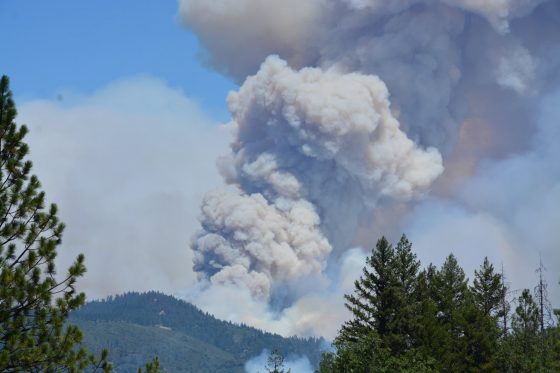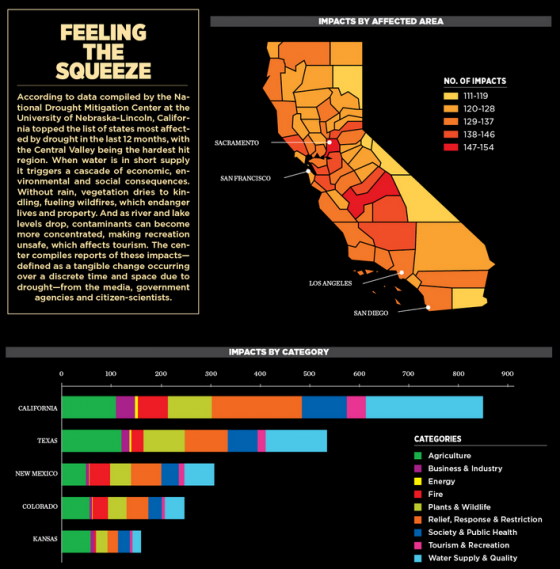
Overnight, the Mendocino Complex Fire in Northern California expanded far enough to oust the 2017 Thomas Fire as the largest wildfire in the state’s history. Comprising two joined fires, the Mendocino Complex Fire has burned through 443 square miles in the area north of San Francisco. As of Tuesday morning, the fires burned more than 140 structures, including at least 75 homes, and was 30% contained.
But California’s residents and businesses still should be on alert, as the incendiary activity doesn’t end there. An unprecedented 14,000 firefighters are combating between 12 and 16 wildfires in the state, according to the Department of Forestry and Fire Protection. Particular emphasis is in Northern California, where the fires in Mariposa and Shasta counties continue to threaten residents, businesses, and emergency responders. For 26 days, the Ferguson Fire in Mariposa County has burned nearly 90,000 acres and caused two fatalities. The fire is having a huge impact on areas near and around Yosemite National Park, which alerted the public that it had closed all but two entrances and roads.
Redding, a city 150 miles north of Sacramento, is the site of the Carr Fire, which has been ablaze for two weeks. Weather.com reported that the fire has caused seven deaths and the destruction of nearly 1,600 structures, the majority of which are homes.
The city of Redding launched an interactive map that provides residents with images of neighborhoods so they can check the status of their homes. Reports indicate that more than 1,800 structures are still in the path of the fire.
Despite such technological advances, many residents have questioned the effectiveness of the state’s emergency notification system, which they rely on for evacuation notices.
The California Governor’s Office of Emergency Services currently uses an integrated California Public Alert and Warning System (CalPAWS) Plan to warn the public of danger.
Affected residents in several areas have claimed that they did not receive the CalPAWS evacuation order – including the great-grandmother who perished in the Carr fire in July with her two great-grandchildren. On Aug. 4, California Gov. Jerry Brown held a press conference in Shasta County to discuss the damage. But California’s emergency notification systems—and its unreliability in certain areas of the state—were a central focus of the conference.
Gov. Brown said he would consider legislation to improve alert systems, acknowledging local lawmakers’ proposals in an effort to create a statewide system that requires registration from all residents.
“I think we do need the best alert system we can get, and that’s what I would help the Legislature achieve,” Brown said, according to the Sacramento Bee. “There’s a lot of things we can do, and we can always do more …
given the rising threats on the changing of the weather, the climate.”
The Bee reported that a bill with adoption plans for a uniform alert system has been drafted:
The bill, Senate Bill 833, would require counties to automatically sign up residents for a uniform cell phone alert system. It would also fund a standardized system equipped to push out alerts on all forms of media—radio, television, electronic highway billboards and landlines. County emergency managers would be required to undergo annual training on the latest alert technology.
Under such a plan, which would utilize the federal Wireless Emergency Alerts system, they’d have to opt out rather than sign up voluntarily.
Furthermore, the governor said he hopes to overhaul the state’s 911 system, which would de-centralize the calls and notifications to ensure more accurate messaging.
Also on Aug. 4, the White House approved California’s request for a Presidential Major Disaster Declaration to help with the impacts of the wildfire in Shasta County.
“This is part of a trend—a new normal—that we’ve got to deal with. We’re dealing with it humanly, financially and governmentally,” Gov. Brown said during a media briefing at the Carr Fire Incident Command Post in Anderson, California. “These kinds of horrible situations bring people together, regardless of the lesser kind of ideologies and partisan considerations.”

